by Tom Gaylord
Writing as B.B. Pelletier
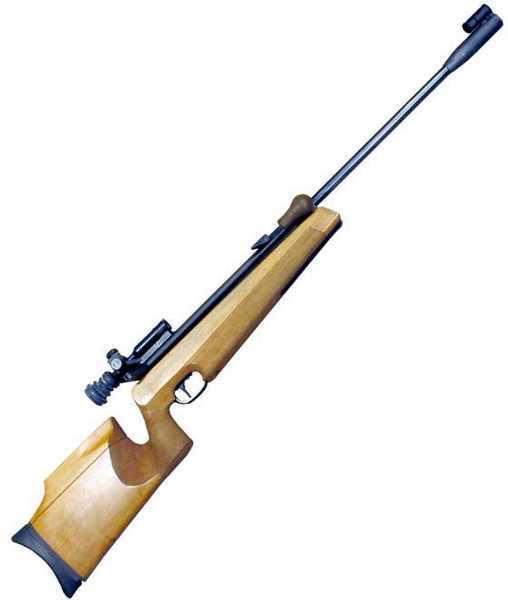
Walther LGR.
This report covers:
- Rothenburg ob der Tauber
- History
- Stock
- Sights
- Fatal flaw?
- Loading port
- Trigger
- Summary
Yes we are starting yet another 10-meter air rifle report. This blog has covered a lot of 10-meter target rifles from the 1960s and ’70s, the time when they first appeared. Here are links to many of the reports.
FWB 300
FWB 150
FWB 110
Walther LGV Olympia
Weihrauch HW 55T
Weihrauch HW 55 Custom Match
Weihrauch HW 55 SF
BSF S54
Haenel 311
Mauser 300SL
El Gamo 126
IZH MP532
Sharp Ace Target Standard
Diana 72
AirForce Edge
Diana 75
Daisy 853
Daisy 888 Medalist
Crosman Challenger 2009
Some of the rifles on this list are not serious target rifles and others are for junior marksmen. And I may have inadvertently overlooked one or two that I have covered in the past 15 years. But today I start to look at the first 10-meter rifle I ever saw — the Walther LGR.
Rothenburg ob der Tauber
In 1976, while visiting the picturesque German town of Rothenburg ob der Tauber, I went into a German gun store and there saw and held a Walther LGR. I was amazed by its size its weight and the beautiful construction. The store owner told me how it operated and that, too, was amazing.
I wanted to buy that rifle but its price was too high. I was a young family man and could not afford such luxuries. I did buy a Diana model 10 pistol that got me started with serious adult airguns, but I had to wait 44 more years for my LGR.
History
According the the Blue Book of Airguns the LGR was made from 1974 until 1989. The Walther LPII pistol that started production in 1967 is probably the first commercial single-stroke pneumatic airgun ever produced. The LGR is also a single-stroke and may be the first target rifle of that type.
The rifle weighs 10.8 lbs, according to the Blue Book. I weighed mine on a balance beam scale and got 10 pounds exactly. Of course the walnut stock will make the weight vary somewhat and the one the Blue Book weighed may have been a Universal model that has a more substantial stock.
The caliber is .177, which it must be for world-cup airgun competition. The Blue Book lists the velocity at 580 f.p.s. which seems pretty brisk for a single stroke. I would have expected something more in the 475-525 region. I have tested this one and will again for you in part 2, but that’s all I’ll say about it for now.
Stock
Being a 10-meter rifle, the LGR stock is set up for competition. The forearm is very deep and square and has an accessory rail that will accept a sling swivel or a hand stop or both. It is stippled generously on both sides and underneath to allow a better grip
The buttstock is unusual, in that the cheekpiece can be set up high or low and out towards the shooter or away, and also slanted front to back through the positioning of two clever plastic posts that fit into special recesses drilled into the top of the butt.
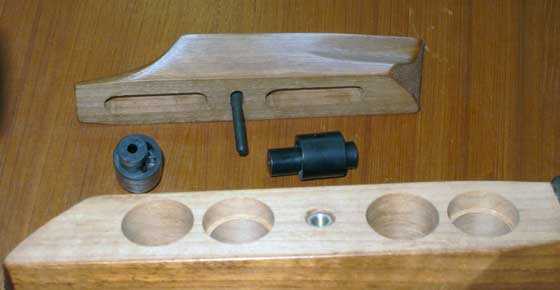
The LGR cheekpiece lifts off and can be positioned by two plastic inserts. It goes from flush with the stock to raised very high, and the inserts have eccentric posts that move the cheekpiece from side to side (toward or away from your cheek).
The curved rubber buttpad adjusts up and down to align the rear sight with the eye. With all the adjustments it should be possible to fit the rifle to most adult marksmen, though the rifle is nowhere near as ergonomic as 10-meter rifles made today.
Sights
The front sight is a globe that accepts inserts. That has long been common to 10-meter target rifles. But this rifle came to me with a clear plastic 3.8mm aperture up front, and that is a welcome upgrade!
As nice as the front sight is, though, it doesn’t hold a candle to what’s in back. It’s a tube-type rear peep sight! For the past 15 years whenever I wanted to talk about tube-type peeps I had to ask reader Kevin to please send me a picture to show. Now I have one of my own. And it seems to accept a lens of some sort, though lenses that magnify are not legal in international competition.
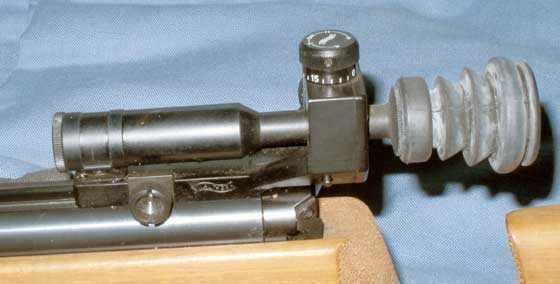
The peep sight is a tube type. There are no lenses inside, though it appears it might accept one.
Fatal flaw?
If the LGR has one flaw it is the fact that the pump arm is hinged in the rear and must be pushed forward to fill the rifle. That makes it more difficult to pump, and that matters in a 60-shot match. If the pump is hinged in front then your leg serves as a place to anchor the buttstock when pumping, but when it’s hinged in back and you pump toward the front it’s all done with your arms. Not a good idea.
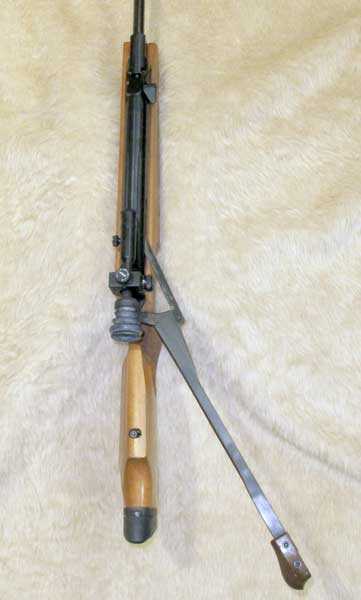
The LGR pump arm is hinged in the rear, making you close the pump stroke to the front. That makes both of your arms get involved every time you pump the rifle.
Loading port
The LGR has a flip-up cover that exposes the rear of the beech for loading. A cutout in the bottom of this area provides a little more room. However, I don’t find it that convenient to load the rifle.
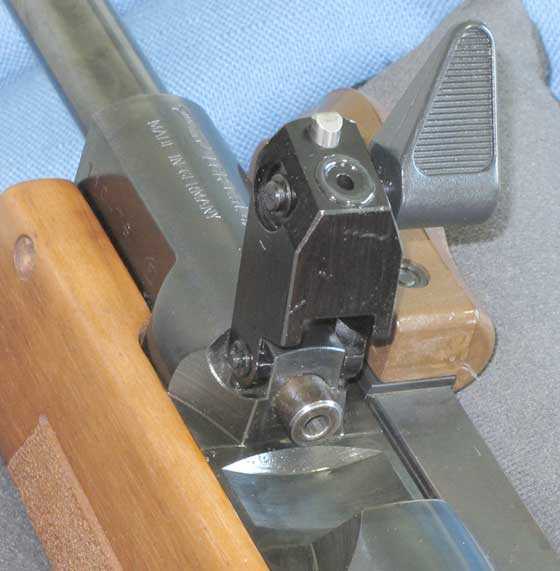
To load the rifle you flip up the loading port like this. Note how the bottom of the area has been scooped out to make more room for the fingers.
Trigger
Since this is a Walther we expect a world-class adjustable target trigger and the rifle doesn’t disappoint. The trigger is two-stage and the straight blade adjusts for position, forward and back. You can also adjust the pull weight and the length of the stage one travel.
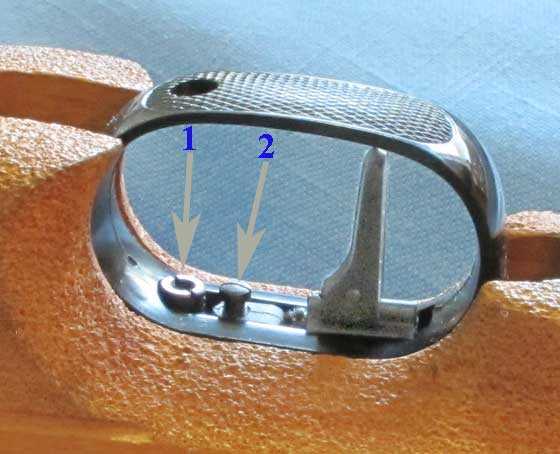
The trigger adjusts for pull weight (screw 1) and length of first-stage travel (screw 2). The trigger blade also slides along its base to make the reach longer or shorter.
Summary
This Walther LGR is a fine vintage 10-meter target rifle. It doesn’t have the ergonomics of modern target air rifles but it was quite advanced for its day. I think it was the equivalent of the FWB 300s and I’m expecting the accuracy to rival it.

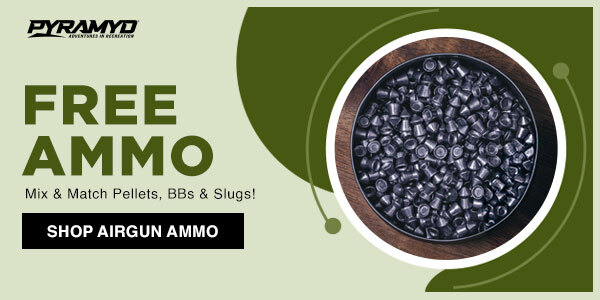
B.B.,
So this is a single stroke pneumatic? Maybe the engineers were trying for decreased distance between the compression chamber and the loading port which is why they made it that way.
Siraniko
Siraniko,
Very likely the engineers converted a sproinger design into a SSP.
/blog/2005/10/diana-rws-46-a-german-underlever/
Do keep in mind this is one of the first SSP 10 meter air rifles. They were still learning and this was an easy modification to an existing design so that production could get it out the door so as to remain competitive.
Writing in the early 1980s, John Walter seems to suggest the development of this was quite protracted:
“It is widely believed that the introduction of the LGR was delayed by problems encountered with the unique [this was in 1984] double-seal breech block, but these were overcome satisfactorily.”
Presumably Anschutz and Feinwerkbau had set the style of a match-winning 10-metre rifle – a fixed barrel for accuracy and a sidelever to allow an accessory rail – and that can hardly be achieved by scaling up the LP2 pistol?
I may be wrong, but I think Webley had a sporting underlever – the Eclipse – in the late 1980s that used this loading method before Diana.
iain
Indeed, the engineers made the gun that way to have less curves in the valve system. They also added a linkage system to the trigger. I have an lgr and it is an amazing piece.
B.B.
While the AirForce Edge that you just reviewed may be more accurate, it is no where near as pretty as this one.
-Y
B.B.
What is the most powerful single stroke pneumatic rifle that was ever made. 20th Century only please?
Thanks,
-Y
Yogi,
The Parker Hale Dragon, I think. Here is a little on it.
/blog/2015/09/the-single-stroke-pneumatic/
It makes 12 foot-pounds.
B.B.
Yogi,
To the best of my knowledge it was the prototype Webley Paradigm. The company went belly up before it went into production. It was just under 12 FPE.
I would not bet on that
BB,
This is very similar to the Diana 46E that my grandson owns.
/blog/2005/10/diana-rws-46-a-german-underlever/
Compressing the air forward like that would most definitely be awkward at best. As I mentioned to Siraniko, the design looks to be a stop gap measure to get one out the door to have something to take on the competition. For it to have been in production as long as it was speaks well of its abilities to be competitive.
I think they may have thought to place the fore end edge against the bench and push the lever forward? Anyway I would think that open palming that knob on the lever wouldn’t be too bad for someone who used that thing every (other) day as a high level shooter would.
Keith
BB,
Looks like a fun one to review. I like odd-ball engineering and that cheek riser and the loading gate fit that bill pretty well. The cocking arm looks like a pain (after having a TX200 and LGU). I would imagine that laying it down on your lap (side to side) might work. Looking forwards to seeing what it can do.
Chris
Good morning!
I am fond of 10 meter rifles and am pleased to see the Walther LGR featured in today’s blog! I’m looking forward to the rest of the series of reports B.B.!
Missing from your list are the Feinwerkbau 600 series 10 meter rifles, maybe you have a report on one of them squirreled away. If not I would hope that you have an opportunity to review one for the history blog or maybe one of those nice new FWB 500 or FWB 800 PCPs that PA lists.
The 580 fps rating for the LGR is not unusual for target rifles these days – my FWB 603 (also a SSP) is shooting around 565 fps.
Though I shoot a fair amount of paper (indoors during the winter) I am not into formal 10 meter target shooting. My FWB 300 (scoped) and FWB 603 see most of their use shooting small (reactive) targets (like Froot Loops or Cheerios or insects) at moderate ranges. Kinda like plinking tins but practicing “aim small, miss small” shooting.
Ten meter rifles are awesome – ultra precise with triggers most guns just dream about! Even if 10 meter target rifles are not your thing you should try shooting one if you ever get a chance …the experience is something like test driving a Porsche. 🙂
Happy Monday All!
Hank
I have a Walther LGM2 that I bought from the local High School Rifle Team (They still have one) when they upgraded to PCP Rifles. It’s probably the best of the breed.
Mike
Mike,
I don’t suppose you could chronograph your rifle for us? 🙂
B.B.
I can do that. I’m at work now but will get to it.
Mike
BB,
Do you still have the Sharp Ace Target that you tested?
Brent
Brent,
Yes, I do. I had it for sale at the Texas Airgun Show for 2 years but people didn’t know what it was.
B.B.
B.B.,
Congratulations on finding a very nice Walther LGR U (Universal). The pinnacle of the LGR series in my opinion. The clever but simplistic adjustment for the cheek piece is wonderful.
Technically, you don’t have a tube sight but rather an anti glare tube attached to the rear diopter sight.
Not sure everyone appreciates what a magnificent piece of history the Walther LGR is.
While Walther was refining their LGV into the LGV Special series, they shocked the competition by introducing an entirely new concept in 1974 — the single stroke pneumatic LGR model. Immediately after its introduction, the LGR broke both the individual and team 10-meter world records. This forced the international shooting union to reduce the size of the 10-meter air rifle target to where it remains today. The LGR also forced all their match air rifle competitors to ultimately drop the springers and move into the pneumatic era.
Kevin,
I wondered about that. The adjustable cheekpiece is what makes this a UniversaL?
B.B.
B.B.,
The adjustable cheek piece and adjustable butt pad make it a Universal. Your trigger should also be adjustable for cant and lop (length of pull). Great gun.
Kevin,
From BB’s picture,… I see trigger LOP adjustment but I am missing the “cant” adjustment. That would typically require a post and shoe set up,… no?
Chris
Chris,
Not if the fore and aft slider is round. There is a small screw in front of the trigger blade that I didn’t see before. I believe it locks the cant position on the blade. I will see if I can show it next time.
B.B.
BB,
I did note that the fixed base looked to have a rounded “shaft” shape that the blade fits on. I figured the side screw would allow fore and aft movement/clamping (as you stated),… but also maybe “rolling” the blade (tip) side to side,…. assuming there is clearance between the 2 parts at the top of the blade. As for a front screw,… I have NO idea how that could figure into the equation. It is not like it is a post and shoe set up.
Looking forwards to what you come up with (assuming the screws will even break loose!) 😉
Chris
BB,
I did some looking around (about the trigger) and ran across this link. Maybe you got it, maybe you don’t,……
https://wikivisually.com/wiki/Walther_LGR
Chris
Chris,
I read the article. ¥es, mine is the Universal. In addition to the cheekpiece and the butt the Universal had a walnut stock that was stippled at the pistol grip and forearm. Mine is all of that
B.B.
BB,
“¥es”,….. what is ¥ ? You gettin’ all fancy on us or maybe learning some new tricks? 😉
Chris
Got it,…. did a copy/paste and came up with this on a search,….
https://en.wikipedia.org/wiki/Yen_sign,…….. you must have left one of your Chinese or Japanese stock windows open? 🙂 (monetary symbol for either)
Kevin,
Yes, the trigger is adjustable for LOP and cant.
B.B.
B.B.,
Gotta love the myriad of nuances incorporated into the design of the LGR U that allows a custom fit for most shooters.
After cleaning the barrel on my Old LGR U it shot falcons well at ranges beyond 10 meters. I know you’re going to test many wadcutters at 10 meters.
Chris,
Dig around on the Huben K1 and you can find exactly how the action works for it and the LCS. It is really pretty neat. Could you make the clip removable? Possibly, but you would be complicating something that is not very simple right now. This is the reason the LCS and the FX Impact are not on my wish list. Too complicated. Too many parts. Too many places for Murphy to raise his ugly head. KISS.
The RTI Arms Prophet has nine o rings throughout the air rifle. It is simpler, faster and cheaper to change from .177 to .22 or .25 or .30 than the FX Impact. It was one of the winning air rifles at EBR this past year, against FX Impacts, etc.
Shootski,
You do not have to wait for one of the days he is open, though you are more likely to meet more of the “local” airgun crowd. You can make an appointment for any day you are in.
He occasionally organizes shoots and will try to remember to let me know when he does another. The last one Nathan had there were around twenty-five people.
Lloyd usually has a small one at his place in the Fall.
BB, you have experience with allot of beautys! That Olympia sure speaks to me.
From 25 to fifty yards, the R1 is the best of the lot maybe, in terms of power and accuracy?
There is something about SSP’s that leaves me a little cold, mind you I wouldn’t complain over this
fine rifle one bit.
Thanks for the dedication!
R
RidgeRunner,
Thanks for the 411! I saw the by appointment but would only do that when i knew i was going to buy something substantial ;^) Getting to meet the other airgunners is half the fun at least of visiting air powered shops.
shootski
Shootski,
Indeed! I met several of the local airgunners Saturday. He even called one of them to come in and see if he wanted my HM1000X. I know my grandson did not have as much fun as I did, but Nathan did keep him interested for quite a bit.
B.B.,
“A cutout in the bottom of this area provides a little more room. However, I don’t find it that convenient to load the rifle.”
If you are loading with Thumb and Index Finger try this Thumb, Index Finger, and Middle Finger method: Place pellet head down on shooting bench (or other level flat surface) with top side of two fingers down on the bench grasp the pellet between the fingers, hold skirt with Thumb, move to loading port and with finger tips in the cut push the pellet into the breech with your Thumb. It takes a little practice to grasp the pellet at the right point between the fingers at first but once you have it down cold you will never be “ALL THUMBS” ever again!
With minor modifications works for most finicky pellet loading.
shootski
I measured the velocities of the slugs I posted pictures of in this comment:
/blog/2020/07/beeman-r10-part-4/#comment-458590
Measured Weight Velocity Energy
Slug Diameter grains fps ft lbs
FX 0.217 22 985 47.4
H&N .218 0.2175 21 1004 47.0
H&N .218 0.218 23 952 46.3
H&N .218 0.2175 25 919 46.9
H&N .218 0.217 27 877 46.1
H&N .218 nt 30
H&N .217 nt 21
H&N .217 nt 23
H&N .217 nt 25
H&N .217 0.216 27 883 46.7
H&N .217 nt 30
nt = not tested, I do not have these slugs to test.
I only measured three shots for the velocity of each size slug, most of each set were close in velocity so I think they are reasonable. I also measured the diameter of three slugs in each size with a rotation of 90 degrees and a second measurement. My impressions are that they are more uniform than is typical with pellets. With the six caliper measurements each size slug two for each of the three pellets they were all within 0.0005 inches with almost all of them giving the same measurement for each size slug.
The FX slug was the hardest to load even though it measured less than some of the “H&N .218” slugs. The H&N .217 slug was the easiest to load. It also measured the smallest diameter at 0.216 inches. My calipers are not the best but do give repeatable results.
It would be nice if someone could run these slugs through a pellet gage and see how that comes out. Guess I could break down and order one. I won’t be sorting but it would be good to test uniformity in a tin of pellets or slugs.
I was finally able to order a right hand magazine for my RAW and it works with a large focus wheel on my scope. The wheel interfered with the left hand magazine and made loading a single shot a little difficult. I still do not have a single shot tray for the gun. I have learned to load it single shot and it is not too difficult without the tray. All the slugs I tested loaded fine with the right hand magazine. I did find that the gun was more accurate with single shot pellets than with the left hand magazine. I hope it is just as accurate with the slugs single shot or magazine.
Don
Don,
Thank you for the update (and link to previous comment). On head sorting,.. I think that slugs might prove quite challenging with a Pelletgage. With a pellet,… you have just the head “rim”. With a slug,.. you have contact all the way. I say stick with the calipers.
If I ever got serious with slugs,.. I would get a sizing die and run ALL of them through it (like a firearm re-loader might do).
The FX vs HN harder loading might be due to harder lead? Don’t know.
Fine work and keep us posted. Looking forwards to the accuracy phase of your testing.
Chris
I was thinking the same thing. The FX slugs may be harder. I may set up a test.
Chris USA,
You are probably right about the FX bullets being harder Lead alloy.
Hmmmm…sizing die…if it isn’t round/balanced the die won’t fix that. It may actually make the round asymmetrical at the base which is worse than not perfectly round going into the bore. With BN 4-6 Lead (soft) the round will probably obturate as it is pushed into the Leade better than it would in a sizing die…just my opinion.
shootski
BB
These vintage 10 meter rifles are pretty much the holy grail of air shooters for me. Accuracy at 10 meters Is tops and some at 25 yards are competitive with high quality springers. This one changed competition at 10 meters. Will be exciting to see if it competes with a FWB300S at 25 yards or more. The advertised velocity gives it a chance.
Deck